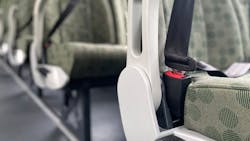Metrolinx’s new buses added to GO Transit fleet this September to include seatbelts
Metrolinx is adding passenger seatbelts to 46 new GO Transit buses during September.
The additions to the GO bus fleet are compliant with Transport Canada legislation mandating any medium and large highway buses built after Sept. 1, 2020, include seatbelts for passengers. The policy change was, in part, in response to the tragic crash in rural Saskatchewan in April 2018 involving a motor coach carrying the Humboldt Broncos hockey team.
These buses are the first to be added to the GO fleet since the legislative change.
“Although this may feel like a big change for GO bus passengers, we know it’s second nature when they travel by car,” said Eve Wiggins, Metrolinx vice president of bus services. “Our job over the coming months will be to communicate clearly, effectively and often with our customers to ensure they buckle up if they board a bus with seatbelts. It’s the law and seatbelts add to the safety measures already built into our GO buses.”
For those traveling with kids, parents or guardians must ensure children are secured in the proper child restraint system for their age and size, using the seatbelt.
The federal legislation does not require the retrofitting of highway coaches built prior to Sept. 1, 2020; however, Metrolinx is currently assessing the implications of retrofitting the existing fleet of 166 single and 267 double decker buses.
While seatbelts add another layer of safety for customers, the GO bus fleet is already designed to exceed federal safety standards, ensuring customers get to and from their destinations safely. In 2014, features were removed from the back of seats, including handles, trays and footrests. GO buses have an additional layer of energy absorbing material layered into the back of seats and double-paned glass to help prevent and minimize injuries in the unlikely event of a collision.
GO Transit bus drivers also undergo a rigorous training program.
Metrolinx has also implemented dozens of health and safety measures to ensure GO buses are clean and provide a safe travel option during the COVID-19 pandemic. In addition to stepping up the frequency of cleaning and disinfecting vehicles and stations, and upgrading air filtration on vehicles and in stations, seat dividers have been added onboard buses.
For those accustomed to the plexiglass barriers onboard GO buses, customers will see a new type of protective divider on the new buses to ensure the divider doesn’t interfere with the seatbelts. Seatbelts will be added to the daily cleaning and disinfecting regimen that takes place when buses are out of service.
Customers will be reminded to buckle up with stickers on GO buses equipped with seatbelts, digital signs and through overhead announcements.
